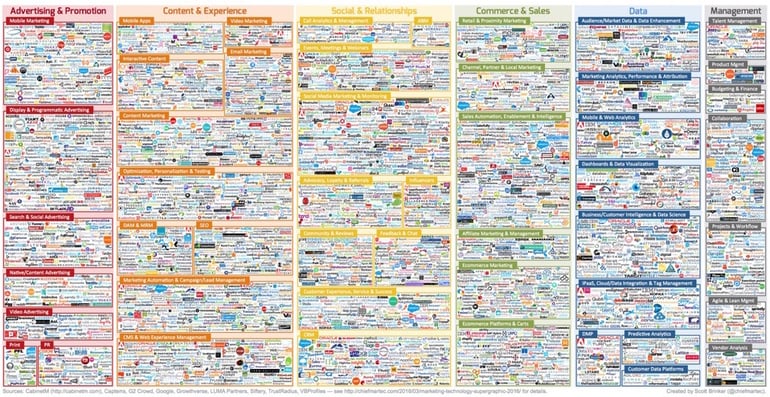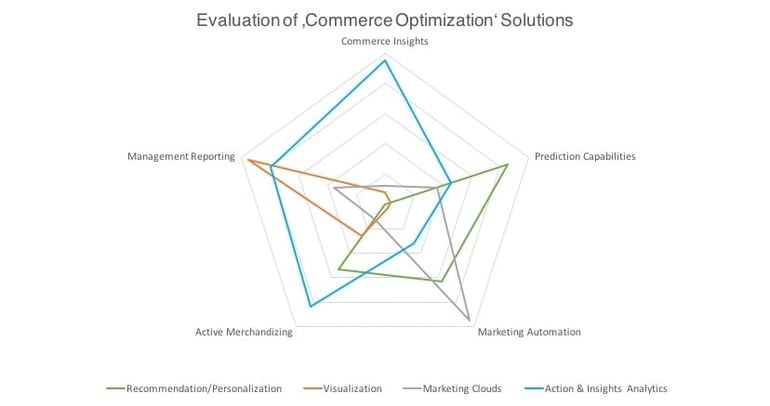Analytics, Reporting, data driven processes, predictive analytics -- who has not heard of these buzzwords before? The large number of solutions to optimize the processes of commerce organizations can be more than overwhelming. It is difficult to differentiate between the various suppliers in the market – let alone to make an informed decision about THE application that will put your company ahead of the competition.
So how do you find the right provider? How can the possibilities offered by different systems be accurately compared? We have also asked these questions and we have developed a model that aims to help you find answers.
Systematization of the Types of Solutions
In our first step, we have taken a look at the existing market of software solutions and services for commerce organizations.
As this chart shows very well, the market confusion is at an all time high. Even the closely circumscribed sector of providers of data-processing solutions for business optimization lacks transparency for anyone who looks at it – it becomes increasingly difficult to distinguish between the different solutions offered. Since we are also affected by this problem as the provider of the minubo Commerce Analytics Cloud, we have taken a closer look at the circle of solutions that have an overlap with ours, and we have divided them into four types – collectively we refer to them as "Commerce Optimization" solutions:
- Recommendation / Personalization Engines
- Visualization Tools
- Marketing Clouds
- Analytics & Insights Solutions
Systematization of Use Cases
In a further step, we have asked the question: which use cases apply in a commerce organization for these applications. For this, we have defined five categories:
- Commerce Insights: Identifying potential for added value to the company, proactive recommendation of concrete measures.
- Prediction Capabilities: predictions about the buying behavior of customers and their interests.
- Marketing Automation: Automated implementation of campaigns across various marketing channels – personalized to the customer's needs.
- Active Merchandising: predictions about future clearance sales based on available historical data, and corresponding introduction of storage operations.
- Management Reporting: creating high-quality reports on the basis of current data analysis, extensively edited and immediately available.
Merging of Types of Solutions and Use Cases
In order to obtain an accurate picture of what type of solution fits which use case, we have merged both dimensions (types of solutions and use case categories) into a spider web diagram:
This diagram demonstrates which solutions fulfill the tasks particularly well or less well:
- Recommendation/Personalization Engines: These solutions detect certain patterns in the present data and thus enable targeted forecasts related to customer buying patterns. In addition, these tools have good applications in the field of marketing automation and Active Merchandising. In terms of management reporting and Commerce Insights, however, these applications are not suitable.
- Visualization Tools: These applications combine data from different source systems and create a visualization of it in the form of dashboards and reports. However, these tools can almost exclusively provide visualization of data, especially of management reporting, but they can hardly be used to prepare operational strategy, which is the main focus of the other use cases (Commerce Insights, Predictive Capabilities, Marketing Automation and Active Merchandising). On top of this, their implementation requires a significant project effort.
- Marketing Clouds: In the field of marketing automation, these applications are of course the absolute leader. They coordinate various marketing campaigns tailored to the various channels, and so control the customer journey for the customer. However, these tools have hardly any Prediction Capabilities and can only be used to a limited extent for the purposes of management reporting.
- Analytics & Insights Solutions (including the minubo Commerce Analytics Cloud): Applications of this group provide all relevant insights that you need, both for strategic management as well as for successful daily business, including high-quality reports on all levels of detail, all relevant company KPIs, and in some cases, even specific recommendations that are proactively pushed to all team members. In addition to Commerce Insights, extensive management reporting and a variety of possibilities in the field of Active Merchandising, these tools can also be considered for marketing automation and Prediction Capabilities. In these use cases, they cannot fulfill the actual task without additional development, but they can be consulted as an important data supplier.
Conclusion
Although vendors of Recommendation/Personalization Engines, Visualization Tools, Marketing Clouds and Analytics & Insights Solutions advertise their solutions usually with all of the commonly used key terms -- the actual applications vary immensely. This makes it essential to take a close look at the providers and compare them to your own requirements. Not every solution is right for your commerce organization and not every solution is appropriate for the implementation of your corporate strategy.
And the moral of the story - the ONE solution does not exist. However, Analytics & Insights Solutions have the broadest scope of applications, since they are data pooling and data preparing technologies and can form the basis for all other solutions. Analytics & Insights Solutions break data silos and provide all the data that is needed in an integrated way for both the core use cases such as reporting, analysis, and operational insights, as well as operationally active tools and, if necessary, automation.


 nach Wunsch auch mit Videocall
nach Wunsch auch mit Videocall
